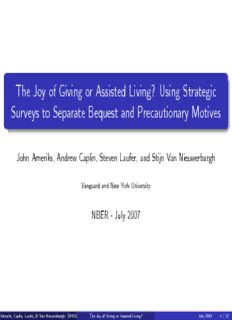
The Joy of Giving or Assisted Living? PDF
Preview The Joy of Giving or Assisted Living?
The Joy of Giving or Assisted Living? Using Strategic Surveys to Separate Bequest and Precautionary Motives John Ameriks, Andrew Caplin, Steven Laufer, and Stijn Van Nieuwerburgh VanguardandNewYorkUniversity NBER - July 2007 Ameriks,Caplin,Laufer,&VanNieuwerburgh (NYU) TheJoyofGivingorAssistedLiving? July2007 1/27 Slow asset run down because of bequest motives: Kotlikoff & Summers (81) precautionary savings motives: Hurd (87), Dynan, Skinner, & Zeldes (02) Models without bequest motive: DeNardi, French, & Jones (06) claim to explain run-down Scholz, Seshandri, & Khitatrakun (06) claim to explain asset build-up pre-retirement ...but, no solid empirical evidence to discard bequest motives Separation tough behaviorally (Dynan, Skinner, & Zeldes, 02): It is not possible to parse net worth into life-cycle and bequest components on an ex-ante basis, because each dollar can effectively serve both purposes. Bequest or Precaution? Retirees spend less than predicted by life-cycle model (Modigliani & Brumberg, 54) Ameriks,Caplin,Laufer,&VanNieuwerburgh (NYU) TheJoyofGivingorAssistedLiving? July2007 2/27 Models without bequest motive: DeNardi, French, & Jones (06) claim to explain run-down Scholz, Seshandri, & Khitatrakun (06) claim to explain asset build-up pre-retirement ...but, no solid empirical evidence to discard bequest motives Separation tough behaviorally (Dynan, Skinner, & Zeldes, 02): It is not possible to parse net worth into life-cycle and bequest components on an ex-ante basis, because each dollar can effectively serve both purposes. Bequest or Precaution? Retirees spend less than predicted by life-cycle model (Modigliani & Brumberg, 54) Slow asset run down because of bequest motives: Kotlikoff & Summers (81) precautionary savings motives: Hurd (87), Dynan, Skinner, & Zeldes (02) Ameriks,Caplin,Laufer,&VanNieuwerburgh (NYU) TheJoyofGivingorAssistedLiving? July2007 2/27 Separation tough behaviorally (Dynan, Skinner, & Zeldes, 02): It is not possible to parse net worth into life-cycle and bequest components on an ex-ante basis, because each dollar can effectively serve both purposes. Bequest or Precaution? Retirees spend less than predicted by life-cycle model (Modigliani & Brumberg, 54) Slow asset run down because of bequest motives: Kotlikoff & Summers (81) precautionary savings motives: Hurd (87), Dynan, Skinner, & Zeldes (02) Models without bequest motive: DeNardi, French, & Jones (06) claim to explain run-down Scholz, Seshandri, & Khitatrakun (06) claim to explain asset build-up pre-retirement ...but, no solid empirical evidence to discard bequest motives Ameriks,Caplin,Laufer,&VanNieuwerburgh (NYU) TheJoyofGivingorAssistedLiving? July2007 2/27 Bequest or Precaution? Retirees spend less than predicted by life-cycle model (Modigliani & Brumberg, 54) Slow asset run down because of bequest motives: Kotlikoff & Summers (81) precautionary savings motives: Hurd (87), Dynan, Skinner, & Zeldes (02) Models without bequest motive: DeNardi, French, & Jones (06) claim to explain run-down Scholz, Seshandri, & Khitatrakun (06) claim to explain asset build-up pre-retirement ...but, no solid empirical evidence to discard bequest motives Separation tough behaviorally (Dynan, Skinner, & Zeldes, 02): It is not possible to parse net worth into life-cycle and bequest components on an ex-ante basis, because each dollar can effectively serve both purposes. Ameriks,Caplin,Laufer,&VanNieuwerburgh (NYU) TheJoyofGivingorAssistedLiving? July2007 2/27 2 Strategic survey as conceptual natural experiment adds new moments to be matched by dynamic programming models passes revealed preference test of Gul & Pesendorfer similarly motivated: Kimball & Shapiro (03) Disentangling Motives: Two Contributions 1 Long-term care (LTC) expenses crucial driver of precautionary motives before: longevity risk (Yaari, 65) more recently: medical expenses (Palumbo, 99 and DFJ) we emphasize LTC as do Brown & Finkelstein (04) we let individual decide how to pay for LTC based on personal preferences Ameriks,Caplin,Laufer,&VanNieuwerburgh (NYU) TheJoyofGivingorAssistedLiving? July2007 3/27 Disentangling Motives: Two Contributions 1 Long-term care (LTC) expenses crucial driver of precautionary motives before: longevity risk (Yaari, 65) more recently: medical expenses (Palumbo, 99 and DFJ) we emphasize LTC as do Brown & Finkelstein (04) we let individual decide how to pay for LTC based on personal preferences 2 Strategic survey as conceptual natural experiment adds new moments to be matched by dynamic programming models passes revealed preference test of Gul & Pesendorfer similarly motivated: Kimball & Shapiro (03) Ameriks,Caplin,Laufer,&VanNieuwerburgh (NYU) TheJoyofGivingorAssistedLiving? July2007 3/27 2 Tremendous heterogeneity in motives substantial group with large bequest motive: 25% of respondents want to provide heirs with 40 or more years of consumption; median bequest motive is 10.5 years another group has very low bequest motive substantial group has both bequest and precautionary savings motives operative Findings 1 Adding strategic survey questions delivers much-improved inference on relative strength of motives! without them, we can only pin down the bequest and precautionary motives within wide ranges with them, we obtain point estimates for most respondents and much narrower ranges for the others Ameriks,Caplin,Laufer,&VanNieuwerburgh (NYU) TheJoyofGivingorAssistedLiving? July2007 4/27 Findings 1 Adding strategic survey questions delivers much-improved inference on relative strength of motives! without them, we can only pin down the bequest and precautionary motives within wide ranges with them, we obtain point estimates for most respondents and much narrower ranges for the others 2 Tremendous heterogeneity in motives substantial group with large bequest motive: 25% of respondents want to provide heirs with 40 or more years of consumption; median bequest motive is 10.5 years another group has very low bequest motive substantial group has both bequest and precautionary savings motives operative Ameriks,Caplin,Laufer,&VanNieuwerburgh (NYU) TheJoyofGivingorAssistedLiving? July2007 4/27 Contributes to Debate on Retirement Spending 1 Anderson, French, and Lam (2004): no asset run-down 2 Kotlikoff and Summers (1981): high actual bequests 3 Hurd (1987): precautionary motives, accidental bequest 4 French and Jones (2004) and DeNardi, French, and Jones (2006): medical expenses central 5 But no direct evidence on bequest motives Ameriks,Caplin,Laufer,&VanNieuwerburgh (NYU) TheJoyofGivingorAssistedLiving? July2007 5/27
Description: